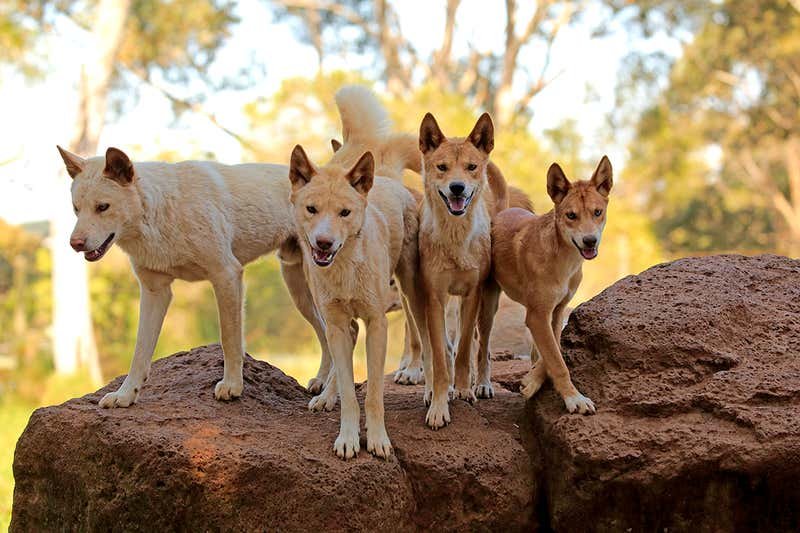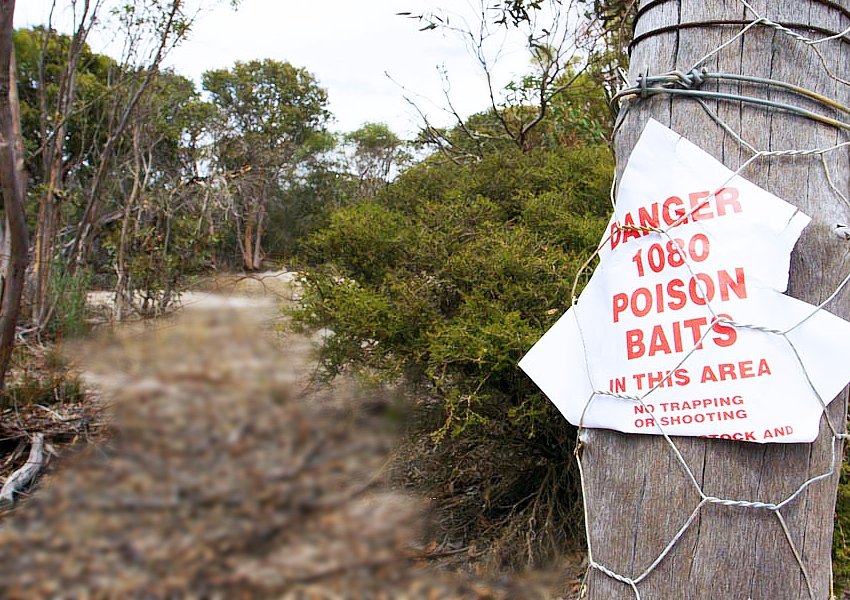REPORT
When Mother Nature fights back - baiting leads to bigger predators, study finds
Dingo pack, Phillip Island. Source: Juergen & Christine Sohns.
A new study led by researchers at the University of New South Wales has revealed an interesting consequence of lethal carnivore control in Australia. The study published in the Biological Journal of the Linnean Society shows that the average size of Australia’s apex terrestrial predator, the dingo, is increasing. What’s more, this change is only occurring in areas where 1080 poison is applied. The findings suggest the development of a new breed of biological bait-resistance and beg the question: could this be the latest in a long line of examples of Mother Nature fighting back?
The Dingo: an icon in peril
The dingo is one of Australia’s most iconic animals. Though the first documented sighting of a dingo was made in the Gulf of Carpentaria by a Dutch navigator in 1623, they have been present on the Australian continent for at least 5000 years. They were first described and given a taxonomic identity nearly 200 years later in 1792.
A dead dingo in 2013 (left) and a Tasmanian tiger in 1869 (right). Photo: Aaron Greenville.
When marauding Europeans invaded Australia less than 250 years ago, dingoes were present and established across the mainland. Before long, their southern equivalent, the Tasmanian Tiger, was entirely eradicated from the mainland. The last wild individual of their kind was killed in Australia’s southernmost state of Tasmania less than 100 years ago. For at least 30 years, the possible extinction of the dingo has become a subject of increasing concern among conservationists.
“True blue” by any other name
If human beings are part of nature, are they merely one life-form among many others, or are they unique in ways that place major responsibilities on them with respect to the rest of the world of life, responsibilities that no other species shares or is even capable of sharing?
Murray Bookchin (1996).
Like dingoes, the Tasmanian Tiger was also considered a “pest” species by nascent colonial pastoralists. Usually defined as a species capable of causing “major economic, environmental and social impacts at local, regional and national scales“, the application of “the pest epithet” signs the death warrant of any animal so labelled. They thereby become increasingly “killable”. Indeed, there is reason to believe that the use of “value-laden” terminology, such as “pest”, reveals an intrinsic bias that can be used to justify extensive lethal control campaigns or even guide environmental agendas. Many contemporary Australians continue to consider the dingo in a strikingly similar manner. This is further reflected in State and Territory legislation which often mandates or actively requires their killing.
For these reasons, dingoes exist in deadly limbo. Paradoxically, as a species with a well-established and accepted presence in Australia stretching back several thousands of years, they are simultaneously accused of preying on other introduced livestock species. As a result, they are mercilessly targeted for destruction, primarily via aerial or ground baiting of 1080 poison.
“Admired and reviled”
The explanation for the popularity or vilification (or protection) of certain animals owes less to the behaviour of particular animals and more to the broader political, social and cultural concerns in human society.
Hilda Kean (2001)
In these ways, dingoes are remarkably similar to other apex predators considered a threat in other regions of the world. As a result, many populations of large predators are declining globally. Like many other large predators worldwide, dingoes are simultaneously admired and reviled. They have been subjected to the priming rhetoric and the orchestrated actions of strategic persecution campaigns. Historically, such misinformation has been crafted and carried out for one of two reasons:
to provide justification for ongoing lethal control programs or;
to create, foster or secure the necessary cultural conditions to confer these programs with the social acceptance they require in order to continue.
A dingo in a shotgun sight. Source: trappers private Facebook page.
Dingoes were among the first Australian species to be targeted with lethal control in a strategic manner. Post-European invasion, it was no longer easy for the dingo to survive. Soon after colonisation, the mass killing of dingoes had become a sport. Indeed, dingo hunting clubs were formed. Bounty systems of the kind previously imposed on the thylacine were soon initiated against the dingo; trappers were (and continue to be) paid a small dividend for killing and scalping dingoes. There is evidence suggesting that the value of such programs is “questionable”. Though such a practice has not been limited to dingoes, they were among the first species to be systematically marked for destruction in such a way.
For example, the systematic killing of dingoes in NSW can be traced to an 1852 Act in NSW crafted to “Facilitate and Encourage the Destruction of Native Dogs” (emphasis added). The inclusion of the term native indicates that this genetic postcode, which often affords an animal a varying degree of protection, is also often not enough to preclude a species from wholesale slaughter. In 1902, this Act would be consolidated to include the laying of poison-laced baits (see frontispiece of the Act below).
A 1902 law passed to legalise the killing of dingoes.
DNA don’t lie
‘Wild dogs’ are perceived to be negative and destructive and worthy of eradication. Our data really shows that the term ‘wild dog’ is misleading – the animals in the wild are dingoes.
- Dr. Kylie Cairns
In November 2019, another pioneering study led by UNSW researchers found that “almost all wild dogs in NSW are dingoes or dingo-dominant hybrids“. Indeed, nearly one in four of the animals sampled were considered to be pure dingoes. Thus, it is reasonable to believe that the strategic vilification and widespread killing of the dingo violates a key component of a common genealogical classification system.
This system considers the existence of a stable population present pre-1788 (pre-invasion) to be a prerequisite for recognition and protection as a native Australian animal. The known presence of dingoes for thousands of years prior to 1788 (or even later dates following initial European invasion) includes them in this category by definition. Yet they have been heavily persecuted across the length and breadth of the continent since that time.
Rock painting of a dingo and an ancestral figure, Queensland. Source: Paul Taçon.
Indeed, there is no guarantee that apparently bonafide native species will be afforded any protection if and when they are perceived as a problem. The plight of another iconic Australian animal, the kangaroo, is a case study in this regard.
Carnivore management is as much a political challenge as a scientific one. As a result, carnivore managers must now invest in intense and prolonged public outreach and engage social scientists to study public approval for management tactics
- Treves and Karanth.
The latest tactic used by authorities and landholders to strategically secure cultural authorisation or acceptance in order to continue large-scale poison baiting programs is the misleading cultivation of a belief in the existence of a “wild dog” problem. This “problem” is allegedly crippling vast tracts of Australia to the tune of tens of millions of dollars a year. Such a scientifically contentious argument is of significant benefit to primary industry operations, such as livestock industries, who are dependent upon unimpeded access to the large swathes of land required for intensive grazing.
Source: The National Wild Dog Action Plan.
It ought to be of little surprise that such a false narrative is based on disputable evidence peddled by either the State or Territory authorities tasked with promoting those same industries or, alternatively, is spread by industry-affiliated figureheads. The latter often enjoy substantial amounts of financial and ideological support from those same government authorities, agencies or departments.
Why do we demonise dingoes?
It has long been known that large carnivores play a critical role in supporting the health and balance of an ecosystem. They do so by suppressing the abundance and impacts of other animals, particularly herbivores and smaller predators. When apex predators are indiscriminately killed, their absence can lead to biodiversity loss. As such, there has been increasing global interest in restoring and protecting their populations.
Follow and support Animal Liberation in their work to ban 1080.
The demonisation of predators has been a constant in human-wildlife conflicts. This has triggered “widespread efforts to eradicate or control them“. Like many other apex predators worldwide, dingoes are simultaneously admired and reviled.They have long been subjected to prolonged vilification and demonisation campaigns. Though similar propaganda has been spread about other species for similar purposes, particularly by livestock industries or special interest groups representing them, few have actively led indoctrination campaigns that depend on the cultural reclassification of a taxon in order to access public support for indiscriminate control operations against them.
Comparable disinformation campaigns have been waged against other species for remarkably similar purposes. For dingoes, the primary purpose is engineering a widespread and socially acceptable perception of their presence as a threat or a problem. Such problems require deadly solutions, perhaps “by any means necessary”. This belief is largely based on their alleged impacts upon primary industries, notably sheep, lamb and cattle operations. Once this is sufficiently achieved, vast tracts of land are peppered with poisoned baits.
A sign warning of the presence of 1080 poison.
Though dingo predation is touted as “a significant threat” in rangeland areas, studies have found that calf loss is “not correlated with dingo activity” and that 1080 poison baiting was “ineffective in protecting calves”. Others have shown that “predator-friendly” practices are far more effective when compared with lethal control techniques. One reason for this is the stabilisation of their social structure. In fact, there is important evidence that suggests “ending lethal control may in itself reduce livestock losses” for this very reason.
The study
Nearly a century after 1080 poison was first used to rid rangelands of unwanted or unwelcome wildlife, new research indicates that surviving animals in baited areas increase in size by between 6 and 9%. This growth accounts for an increase in body mass by up to one kilogram.
The findings suggest that 1080 baiting programs could be “favouring the survival of larger dingoes” because less poison is required to kill smaller animals. As a result, larger animals survive and continue to breed individuals of increasingly larger sizes. What’s more, if baiting is changing dingoes it could be changing other animal populations as well.
This latest study is important for a range of reasons. Key among them is the fact that persecuted animals are fighting back. We’ve all heard about individual animals struggling against their own personal oppressions. Chautauqua, the horse who famously refused to race, is an excellent example. We are aware of no other recent example of a vertebrate species developing an innate or biological challenge the likes of which have been found in the dingo.
- Alex Vince, Coalition campaign director
Though a possible solution to this is adding more poison to baits intended for dingoes, the researchers have warned that “eventually, the cycle will start again” unless significant changes in carnivore control are made.
While other species, particularly invertebrates, have developed changes in morphology or increases in venom production after ingesting sublethal doses of other pesticides or herbicides, this study reveals the existence of a similar biological challenge in vertebrates. As the researchers explain, “our interventions have consequences [and] side effects“. Moreover, these consequences are considered “quite predictable“.
Evidently, alternative methods are urgently needed.
Other unintended consequences
Meat-based 1080 baits. Source: Eliza Wood.
Globalisation has diminished the natural boundaries that once restricted species within distinct regions. As a result, modern ecosystems are increasingly characterised by ecological communities containing both native and introduced animals. Within these, apex predators are described so due to their peak position on an ecosystem’s pecking order. That is, their presence limits the population sizes of other, smaller animals. The suppression of smaller predators is an important ecological process for a range of reasons. Key amongst these is the prevention of unsustainable predation by mesopredators on small prey species.
We should be listening to sound science, ethics and our own consciences to demand an end to indiscriminate killing at once. We’ve entirely erased once-endemic species from this continent in the not-too-distant past. We’ve been using the same poison for decades and the most we can claim is that it has killed countless animals in the most horrific manner imaginable. If we don’t listen now and if we don’t act before it’s too late, it seems they are developing ways to do it in spite of us.
- Alex Vince, Coalition campaign director
Ultimately, dingoes have been “pushed to be brink” of extinction by bullets, as in the image above, or by poison-laced baits such as those below. The primary cause of this is intractable conflicts with humans, particularly our extensive use of land for livestock production enterprises and the perceived competition this causes with wild animals.
It does not need to be this way.
How you can help save Australia’s dingoes
Join the Coalition today.
Follow us on Facebook
Share our petitions and our resources.










